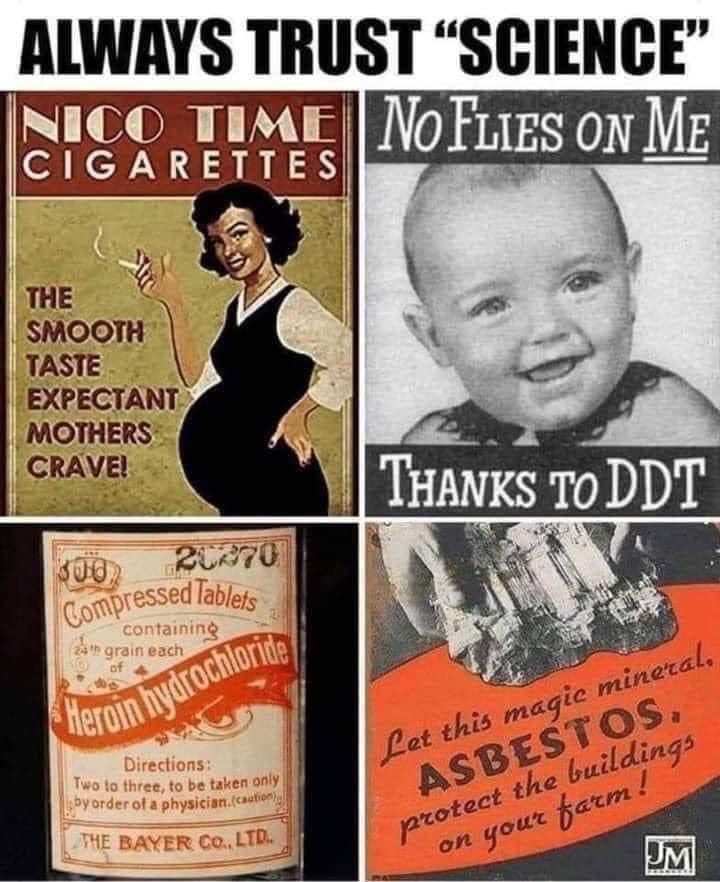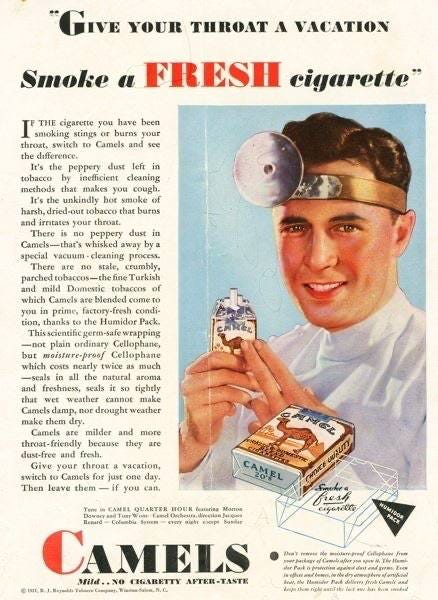Always Trust "Science"
No flies on me thanks to DDT!
From a USA Today Fact Check article, one of these ads is fake:
DDT was "the first of the modern synthetic insecticides in the 1940s," according to the U.S. Environmental Protection Agency. And a poster promoting it as an insect protectant for children is real.
The Gallery of Graphic Design said it appeared in the Jun 1, 1946, edition of Woman's Day magazine. The group compiles graphic art from the 1930s to the 1960s.
It was an advertisement for the insecticide company Black Flag, which produced DDT. The full poster is accompanied by a caption that says the substance is preferred by housewives for killing flies and mosquitoes and emphasizes that it "stays on walls, floors, doorways to keep on killing flies for weeks!"
According to the EPA, DDT was initially used with great effect to combat malaria and typhus, as well as other insect-borne human diseases among military and civilian populations. It was also used effectively as insect control in crop and livestock production, institutions, homes and gardens.
The U.S. banned the use of DDT in 1972 after finding it was harmful to humans in high doses, but it is still used in some countries, according to the U.S. Centers for Disease Control and Prevention.
An advertisement that promotes “Heroin hydrochloride” from The Bayer Co. is also real.
A German group called the Coalition Against Bayer Dangers posted a similar version of the ad, which promoted the use of heroin by children to alleviate cough and "irritation" symptoms.
A century ago, scientists at a German pharmaceutical company chemically modified morphine to make it easier to take as a cough suppressant, according to the Yale School of Medicine. The Bayer Co. marketed the drug as "Heroin" and started production in 1898 on a commercial scale. By 1912 it had become a recreational drug.
In 1914, the passage of the Harrison Narcotics Act aimed to regulate the use of opium, a key ingredient in heroin, in the U.S.
In 1920, the American Medical Association adopted a resolution that said heroin should be "eliminated from all medicinal preparations" and prohibited for sale in the United States.
That was nearly three decades before the CDC was created.
The asbestos advertisement is real.
The ad has a "JM" logo, which stands for Johns Manville, an insulation manufacturer.
The ad can be found on the Asbestos Institute website with the caption "Johns-Manville pamphlet portraying asbestos as the 'Magic Mineral of the Middle Ages.'" It identifies the pamphlet as being from 1937.
In 1990, the company was involved in a series of lawsuits as hundreds of plaintiffs alleged they had suffered from inhaling asbestos at the Brooklyn Navy Yard 25 years prior.
The website for the National Institute for Occupational Safety and Health says people "occupationally exposed to asbestos have developed several types of life-threatening diseases, including asbestosis, lung cancer and mesothelioma."
A “Nico Time” advertisement that promotes smoking during pregnancy is fake. It was posted in a Fandom page called "BioShock Wiki," which is dedicated to the video game series BioShock. The site wrote that the advertisement was designed by Kat Berkley, a concept artist who worked on the game.



